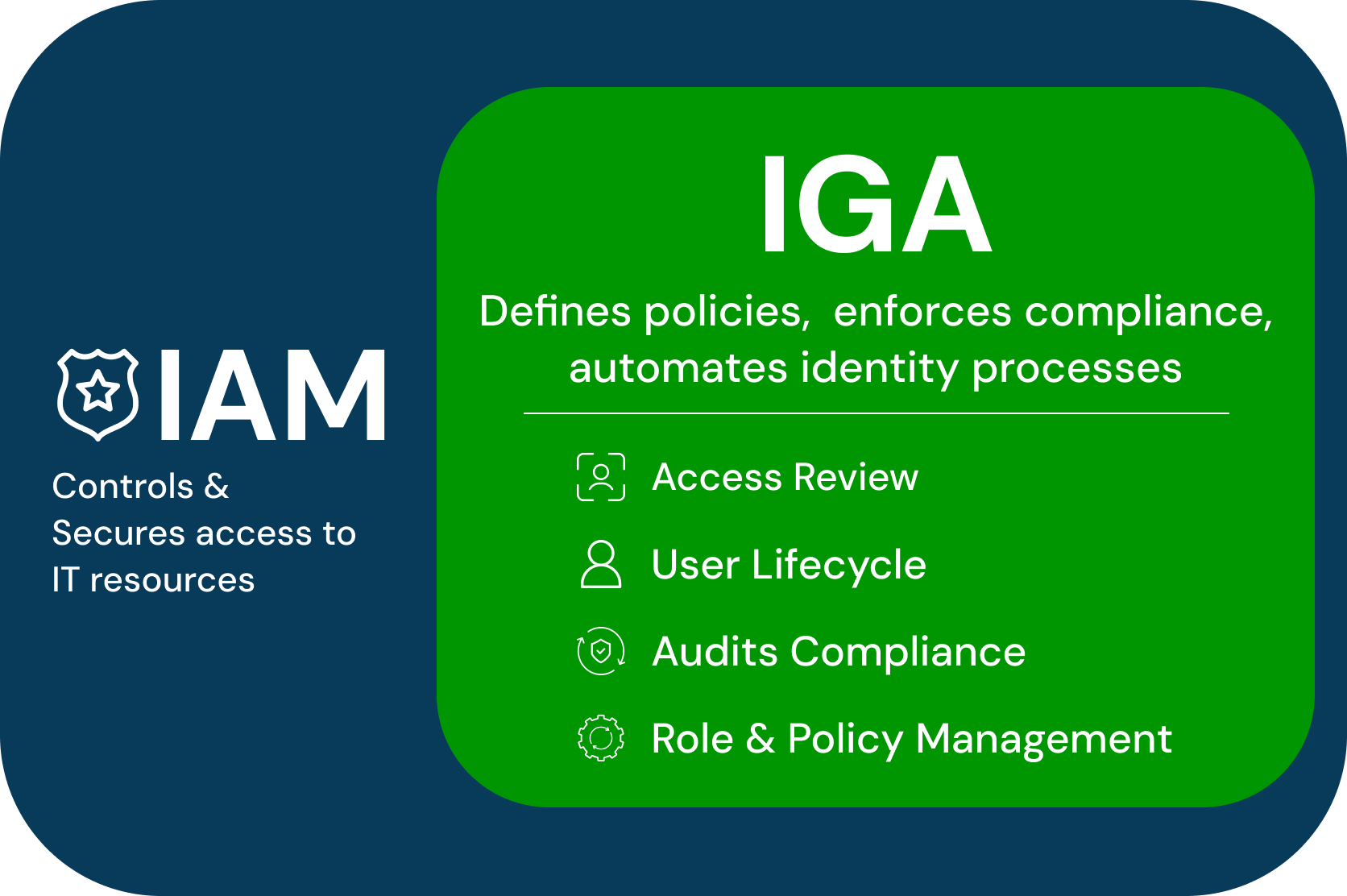
Key Difference Between Identity Access Management (IAM) and Identity Governance Administration (IGA)

Why Understanding IAM vs. IGA Matters
As we are aware, IAM (Identity and Access Management) and IGA (Identity Governance and Administration) both primarily focus on managing user identities and controlling user access privileges. Yet they serve different but complementary purposes. While IAM ensures that the right individuals can access the right resources at the right time. In IAM, it's all about authentication, authorization, and enforcement. On the other hand, IGA goes a step further by adding oversight, compliance, and policy enforcement into the mix, making it a governance layer on top of simple IAM processes. Understanding the IGA and IAM relationship allows organizations of any size to move from reactive access management to proactive risk mitigation, helping IT and security teams answer important questions such as, who has access, and to what resources? Should they really have access to a particular resource? And who approves/overlooks the same?
The Role of IAM and IGA in Modern Enterprises
Identity Access Management (IAM) offers the first line of defense; this is done by managing identities and securing their access. All this is fine, but without proper governance , even well-managed access can lead to compliance gaps and major security loopholes.
That’s where identity lifecycle management and access governance solutions come into play. IGA works by enhancing the existing IAM framework. It automates the joiner-mover-leaver process (provisioning and deprovisioning) by continuously validating access rights and ensuring that permissions align with organizational (predefined) policies.
Implementing integrated governance solutions empowers businesses to:
- Automate the process of access provisioning & deprovisioning
- Reduces the risk of privilege misuse.
- Helps in passing the audits with ease, and
- Aligns access policies with regulatory mandates.
What is IAM (Identity and Access Management)?
Definition and Core Purpose
Identity and Access Management (IAM) is a cybersecurity framework that helps in enabling organizations and companies to control who can have access to what all resources, when, and under what conditions. Overall, IAM ensures that only the right users, be it employees, or contractors, or third-party applications, can access the appropriate systems, data and resources needed to perform their tasks, nothing more, nothing less than that.
As defined by Gartner - IAM is ‘the discipline that enables the right individuals to access the right resources at the right times for the right reasons.’ IAM helps organizations to not only adjust and respond to system changes in the business environment but at the same time be proactive in identifying any type of identity-related risks related to access.
The goal is to strengthen security by preventing unauthorized access and boost efficiency by automating access workflows. IAM plays an important role in aligning user identity with some predefined access policies across an organization’s digital ecosystem, ranging from on-premises infrastructure to cloud applications.
Key Components: Authentication, Authorization, and Access Control
IAM systems are primarily known to be built on three important components:
- Authentication: This helps in verifying an employee’s digital identity by using various methods like passwords, biometrics, OTPs, or multi-factor authentication (MFA). It ensures the user who is trying to get access to the system is exactly who they claim to be.
- Authorization: after the user’s identity is authenticated, the process determines what actions or data or even resources the user is allowed to gain access, based on their roles, groups, or predefined policies of the organization, if any.
- Access Control: This enforces rules and restrictions to ensure users can access only what they’re permitted to do. This can be role-based access control (RBAC) or attribute-based access control (ABAC), or even a combination of both of these.
IAM Benefits for Operational Security and Efficiency
Implementing a strong IAM framework has its own set of advantages; let us have a look at a few of them.
- Enhanced Security: An identity management system enhances security by limiting access to sensitive systems, resources, and applications. All this is done while automating credential management. IAM minimizes exposure to data-related breaches and insider threats.
- Streamlined User Management: Onboarding, offboarding, and role changes (the entire journey of provisioning and deprovisioning) are handled efficiently through automated workflows.
- Regulatory Compliance: IAM helps to fulfill strict data protection standards as well as adherence to compliances like GDPR, HIPAA, and SOX by logging access events and enforcing least-privilege policies (PLOP).
- Operational Efficiency: With centralized access control, IT workload is reduced, manual errors are eliminated, and users are allowed to get timely access to the tools they need, improving productivity without compromising security.
What is IGA (Identity Governance and Administration)?
Identity Governance and Administration, or IGA is a cybersecurity framework that combines policy, automation, and oversight to govern user identities and control their access within an organization. This is different from traditional IAM, which focuses mainly on authentication and access control. On the other hand, IGA penetrates deeper into the governance aspect and ensures that access is not just granted but continuously reviewed, monitored, and revoked when it is no longer needed.
Identity Governance and Administration (IGA) works by linking user identities with the resources/applications that they can access and enforcing policies to ensure that these privileges align with organizational roles, policies, compliances, and business needs.
Core Functions: Access Certifications, Role Management, Policy Enforcement
IGA solutions offer several critical capabilities that help tighten identity governance:
- Access Certifications: Through access certifications, periodic reviews are conducted that allow managers to grant or revoke access rights based on current responsibilities. This helps in reducing the risk of privilege creep and unauthorized access.
- Role Management: Role management within IGA lays the foundation for scalable and consistent access control. It supports multiple models to suit varying organizational needs:
- RBAC (Role-Based Access Control) RBAC assigns permissions based on predefined job roles/responsibilities, this makes it easy to manage access for users performing similar job responsibilities.
- ABAC (Attribute-Based Access Control) offers more flexibility by granting access based on user attributes such as department, location, or device.
- PBAC (Policy-Based Access Control) This combines elements of both RBAC along with ABAC, by using logical policies to define who can gain access. And what under which conditions? making it ideal for complex and regulated environments.
- Policy Enforcement: Automatically applies governance policies across systems such as separation of duties (SoD), least privilege, and conditional access, ensuring all access aligns with internal controls and regulatory requirements.
IGA for Compliance, Visibility, and Lifecycle Governance
In today’s regulatory and risk-heavy environment, IGA plays a central role in enabling secure, auditable, and efficient identity operations:
- Compliance: IGA tools provide audit-ready logs, automate reporting, and support frameworks such as SOX, GDPR, HIPAA, and ISO 27001 helping organizations stay compliant with evolving industry mandates.
- Visibility: With centralized dashboards and activity logs, security teams gain a clear, real-time view of who has access to what systems, when that access was granted, and whether it's still necessary.
- Lifecycle Governance: From onboarding to offboarding, IGA automates the entire identity lifecycle. It ensures timely provisioning, adjusts access when roles change, and immediately revokes access when users leave—minimizing orphaned accounts and reducing risk exposure.
IAM vs IGA: Key Differences
Scope and Coverage Comparison
IAM (Identity and Access Management) focuses on the day-to-day operations of granting and managing access to systems, applications, and data. Its primary goal is to ensure users have the right level of access to do their jobs efficiently and securely.
IGA (Identity Governance and Administration) takes a broader, policy-driven approach. It not only manages access but also governs how that access is assigned, reviewed, and revoked. This ensures every permission aligns with internal policies and compliance mandates. IGA is concerned with why access is given, how long it should remain, and who can approve it.
In essence:
- IAM = Access Enabler
- IGA = Access Oversight
Compliance and Audit Capabilities
IAM helps organizations strengthen access security through authentication and authorization, but its compliance features are often basic focused more on control than evidence.
IGA, on the other hand, is built for compliance. It provides:
- Detailed audit trails
- Automated access reviews and certifications
- Policy enforcement (e.g., Separation of Duties)
- Real-time reporting for regulations like GDPR, HIPAA, SOX
Organizations facing intense regulatory scrutiny rely on IGA to prove access legitimacy and maintain audit-readiness at all times.
System Integrations and Data Visibility
IAM typically integrates with applications to streamline access provisioning, login workflows, and SSO.
IGA integrates not just with applications but with identity sources, HR systems, compliance tools, and ITSM platforms to unify identity and access data across the enterprise. This allows organizations to:
- Visualize who has access to what
- Map entitlements across systems
- Detect access anomalies at scale
IGA’s broader integration landscape provides 360° visibility, making it easier to monitor, certify, and govern access across fragmented IT environments.
Lifecycle Management Approaches
IAM handles identity lifecycle events—onboarding, role changes, and offboarding—with efficiency and automation. It ensures users get the access they need when they need it.
IGA builds on this by adding governance controls to every lifecycle stage:
- Automating approvals and access requests
- Enforcing access recertifications
- Aligning access changes with compliance policies
In short, IAM manages the execution of lifecycle events, while IGA governs the validation of those events.

Detailed Comparison of IAM and IGA
IAM vs IGA: Core Differences at a Glance
| Aspect | IAM (Identity and Access Management) | IGA (Identity Governance and Administration) |
|---|---|---|
| Primary Focus | Grants and manages user access | Governs, audits, and certifies access |
| Scope | Operational: authentication, authorization, and access provisioning | Strategic governance: compliance, and lifecycle oversight |
| Access Control Models | Role-based (RBAC), attribute-based (ABAC) | Policy-based (PBAC), with enforcement of least privilege and SoD |
| Authentication & SSO | Core functionality (MFA, SSO, password policies) | Indirect: depends on integration with IAM |
| Authorization Management | Assigns access based on roles/groups | Reviews, validates, and certifies access decisions |
| Lifecycle Management | Automates provisioning and deprovisioning | Adds governance via approvals, recertifications, and audit trails |
| Compliance & Audit | Basic logging and access reporting | Deep audit readiness, access certifications, policy enforcement |
| Visibility | Limited to direct access relationships | Full identity mapping and entitlement visibility across systems |
| Integration Scope | Integrates with specific systems/apps | Integrates with IAM, HR, ITSM, and compliance platforms for full view |
| Use Case | Ensures users can log in and access systems securely | Ensures users should have access and that it's reviewed regularly |
IAM as Enabler, IGA as Enforcer
Think of IAM as the gatekeeper it opens the door to users with valid credentials and assigns them permissions to systems based on roles or groups.
IGA, however, plays the role of the auditor and policy enforcer—it checks whether the access granted is appropriate, still necessary, and compliant with regulations.
Together, they work as two sides of the same coin:
- IAM ensures secure and timely access
- IGA ensures that access is appropriate, compliant, and justified
While IAM makes access possible, IGA ensures that access is right.
Tech Prescient’s Approach to Modern IGA
Solving Complex Access Governance Challenges
At Tech Prescient, we understand that identity governance isn’t just about managing access, it’s about managing risk, accountability, and scalability. Our modern IGA solution is purpose-built to solve real-world access governance challenges faced by growing enterprises, such as:
- Lack of visibility into who has access to what
- Manual, error-prone access reviews
- Orphaned accounts and privilege sprawl
- Compliance pressure from evolving regulatory frameworks
By bringing intelligent automation, policy-driven controls, and full visibility into your identity landscape, Tech Prescient empowers security and IT teams to shift from reactive access management to proactive identity governance.
Conclusion
IAM and IGA as Two Halves of a Secure Identity Strategy
IAM and IGA aren’t competing technologies; they’re complementary pillars of a resilient identity security strategy. IAM ensures secure access execution, while IGA ensures that every access decision is governed, justified, and reviewed.
Without IAM, access can’t happen. Without IGA, access can’t be trusted.
See Tech Prescient in Action
Discover how Tech Prescient’s IGA solutions help enterprises reduce risk, achieve compliance, and accelerate digital transformation.